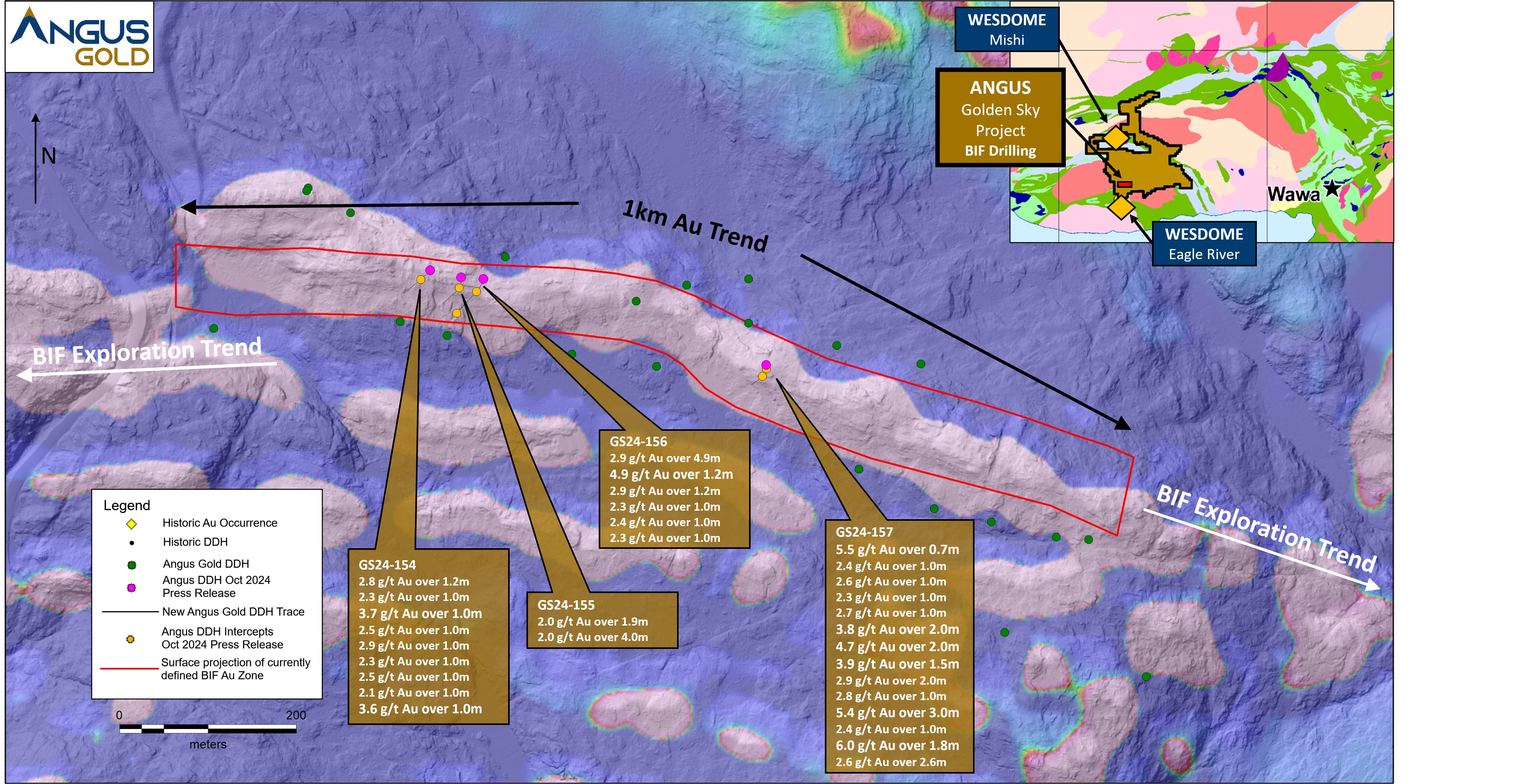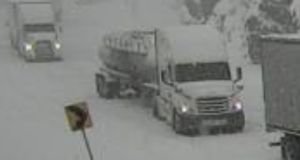Angus Gold Inc. is pleased to announce assay results from the first four (4) exploration holes that were completed on the BIF Gold Zone as part of its August 2024 drill program at the Golden Sky Project in Wawa, Ontario.
Highlights:
- The main focus of the 2024 drill program was to improve both our understanding of the size of the BIF Gold Zone and the geometry of higher-grade ore shoots at depth.
- Down-plunge drilling results at the BIF Gold Zone indicate the mineralized system is thick and continuous:
- Hole GS24-157 returned 111.0 metres of mineralization grading 1.0 g/t Au, including 5.4 g/t Au over 3.0 metres and 6.0 g/t Au over 1.8 metres.
- All down-plunge drilling results provided useful information for interpreting the preferred orientation of higher-grade ore shoots at depth to improve future targeting.
- New gold mineralization intersected at 270 metres true depth:
- Hole GS24-156 returned 9.6 metres of mineralization grading 1.1 g/t Au, indicating the system has significant depth potential.
- Additional BIF Gold Zone drilling results expected in the coming weeks.
Breanne Beh, Chief Executive Officer of Angus, states: “We are very pleased with the results so far from our 2024 BIF drilling program, with additional results expected in the coming weeks. These four holes were designed specifically to improve our understanding of the size and geometry of the mineralization at the BIF Gold Zone. The results of GS-24-157 are incredibly encouraging as we were able to gain a better understanding of just how large this BIF-hosted gold system could potentially be. Within the mineralized intervals we had over a dozen high-grade samples between 2 and 8 g/t Au, confirming the potential for higher-grade shoots. We are currently modeling these results in 3D to identify preferred orientations of the high-grade mineralization. In addition, the discovery of another zone of mineralization at depth in GS-24-156 is very encouraging as it indicates the continued exploration potential of the 6.0 kilometres of banded iron formation present on the Golden Sky property. BIF-hosted gold deposits are extremely complex, however, we have made significant progress over a relatively short period of time. These current results were successful in providing the information we need to advance our model another step forward and will allow us to plan our next drill program to begin defining the high-grade zones.”
The 2024 drilling program on the BIF was designed to test new hypotheses regarding the structural controls on the gold mineralization. The four (4) drill holes published in this press release were designed with the intention of understanding the size of the low-grade envelope of gold mineralization in the BIF Gold Zone in addition to, improving the understanding of the geometry of the apparent high-grade ore shoots plunging within. All four holes returned numerous intersections of > 2.0 g/t Au material within a broad envelope of low-grade gold mineralization. This information is now being used to help improve the modelling of what were thought to be repeated high-grade ore shoots. Hole GS-24-157 was most successful at defining the extents of the gold system with two separate intersections of gold mineralization grading 1.0 g/t Au, one of 12.0 metres and the second of 111.0 metres, including a dozen high-grade intercepts >2.0 g/t Au. With these results we can begin to visualize how large the BIF Gold Zone system is. The thickness and continuity of the results continue to indicate strong potential for the area to host significant BIF-hosted gold mineralization.
In addition, hole GS-24-156 was successful at intersecting a new zone of gold mineralization grading 0.8 g/t Au over 16.9 metres, including 2.3 g/t Au over 1.0 metres and 2.4 g/t Au over 1.0 metres, at 270 metres true depth. This is the deepest hole that has been drilled on Angus’ BIF Gold Zone to date and indicates the continued potential for new zones of mineralization to be discovered.
Similar to GS-24-157, holes GS-24-154, GS-24-155 and GS-24-156 returned a pattern of repeating > 2.0 g/t Au intersections within a broad envelope of lower-grade Au mineralization. These initial results are encouraging and indicate the potential for repeated or stacked ore shoots within the large mineralized system. Notable intersections are listed in the table below.
Selected drill results from the 4 holes at the Golden Sky drilling program are, as follows:
| Hole Number | From (m) | To (m) | Length (m) | Au g/t | Area |
| GS-24-154 | 10.9 | 14.0 | 3.1 | 1.6 | BIF |
| including | 12.8 | 14.0 | 1.2 | 2.8 | |
| GS-24-154 | 77.6 | 78.6 | 1.0 | 2.3 | |
| GS-24-154 | 85.5 | 130.0 | 44.5 | 0.7 | |
| including | 98.0 | 99.0 | 1.0 | 3.7 | |
| including | 100.0 | 101.0 | 1.0 | 2.5 | |
| including | 103.0 | 104.0 | 1.0 | 2.9 | |
| including | 118.0 | 119.0 | 1.0 | 2.3 | |
| including | 122.0 | 123.0 | 1.0 | 2.5 | |
| including | 125.0 | 126.0 | 1.0 | 2.1 | |
| GS-24-154 | 146.0 | 147.0 | 1.0 | 3.6 | |
| GS-24-154 | 158.0 | 166.0 | 8.0 | 1.1 | |
| GS-24-155 | 97.5 | 143.0 | 45.5 | 0.8 | BIF |
| including | 99.0 | 100.9 | 1.9 | 2.0 | |
| including | 106.5 | 111.0 | 4.5 | 1.2 | |
| including | 114.0 | 121.0 | 7.0 | 1.0 | |
| including | 126.0 | 131.0 | 5.0 | 1.5 | |
| GS-24-155 | 158.0 | 162.0 | 4.0 | 2.0 | |
| GS-24-156 | 12.8 | 21.6 | 8.8 | 1.7 | BIF |
| including | 15.2 | 20.1 | 4.9 | 2.9 | |
| GS-24-156 | 82.1 | 89.0 | 6.9 | 1.0 | |
| including | 87.0 | 88.0 | 1.0 | 2.9 | |
| GS-24-156 | 123.0 | 144.0 | 21.0 | 0.9 | |
| including | 123.0 | 127.0 | 4.0 | 2.0 | |
| including | 132.0 | 136.0 | 4.0 | 1.3 | |
| including | 141.0 | 142.0 | 1.0 | 2.3 | |
| GS-24-156 | 269.0 | 285.9 | 16.9 | 0.8 | |
| including | 276.3 | 285.9 | 9.6 | 1.1 | |
| including | 278.0 | 279.0 | 1.0 | 2.3 | |
| including | 283.9 | 284.9 | 1.0 | 2.4 | |
| GS-24-157 | 50.0 | 62.0 | 12.0 | 1.0 | BIF |
| including | 55.7 | 56.4 | 0.7 | 5.5 | |
| including | 60.0 | 61.0 | 1.0 | 2.4 | |
| GS-24-157 | 107.0 | 218.0 | 111.0 | 1.0 | |
| including | 108.0 | 109.0 | 1.0 | 2.6 | |
| including | 112.0 | 113.0 | 1.0 | 2.3 | |
| including | 115.0 | 116.0 | 1.0 | 2.7 | |
| including | 131.0 | 133.0 | 2.0 | 3.8 | |
| including | 139.0 | 141.0 | 2.0 | 4.7 | |
| including | 145.5 | 147.0 | 1.5 | 3.9 | |
| including | 158.0 | 160.0 | 2.0 | 2.9 | |
| including | 173.0 | 174.0 | 1.0 | 2.8 | |
| including | 179.0 | 182.0 | 3.0 | 5.4 | |
| including | 185.0 | 186.0 | 1.0 | 2.4 | |
| including | 202.0 | 203.8 | 1.8 | 6.0 | |
| including | 215.4 | 218.0 | 2.6 | 2.6 |
(1) Assay results presented over core length. Additional drilling will be necessary to constrain the true width of the mineralized envelope of the gold system.

Figure 1: Surface Map – BIF new drilling, Golden Sky Airborne Magnetics Map
The Golden Sky Project
The 100%-owned Golden Sky Project is located within the Mishibishu Lake Greenstone Belt of Northern Ontario, which is host to Wesdome’s high-grade Eagle River and the Mishi open-pit gold mines. The Company’s 290-square-kilometres land package is located approximately 50 kilometres west of the town of Wawa and is situated immediately between the two Wesdome mines.
The ongoing drill program on the Golden Sky Project is focused on the Dorset Gold Zone, which hosts a historic gold resource; the BIF Zone, a new gold zone discovery in a large banded iron formation; as well as the Eagle River Splay deformation zone, which shows potential for another extensive gold system. Angus’ drill programs on the near-surface Dorset Gold Zone have been successful at extending the strike length of the previously modelled zone from 750 metres to 1.7 kilometres. The Dorset Gold Zone historic estimated resource (using a 0.50 g/t Au cut-off) consists of an indicated resource of 40,000 ounces of gold (780,000 tonnes grading 1.4 g/t Au), and an inferred resource of 180,000 ounces of gold (4,760,000 tonnes grading 1.2 g/t Au). For greater details on the Golden Sky Project, please refer to the NI 43-101 technical report for the Golden Sky Project entitled, “NI 43-101 Technical Report Wawa Property Ontario, Canada” dated February 18, 2020, and available on the Company’s SEDAR profile.
- Mixed Curling Standings – December 13 - December 13, 2025
- Ladies Curling Standings – December 12th - December 12, 2025
- Municipality of Wawa Partners with SECFDC to Administer Municipal Accommodation Funds - December 10, 2025
 Wawa-news.com You can't hear the 'big picture'!
Wawa-news.com You can't hear the 'big picture'!

